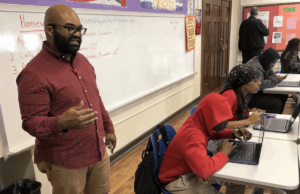New Tools + New Schools = Big Opportunity

For 20 years, education has been driven by standards-based reform. The focus on test-driven accountability resulted in a much-needed focus on data but in a narrow way that was often disconnected from powerful learning experiences. Standards-based reforms created an awareness of the value of great teachers and underscored the importance of an ecosystem that recruited, trained, and supported great teachers and leaders. But standards-based reforms largely failed to produce the intended dramatic improvement.
Talent matters–that was Wendy Kopp’s insight two decades ago. She began recruiting graduates from top universities, built a quick summer preparation program, and placed the Teach for America teachers in high need schools. Leadership matters is the mantra of New Leaders, a nonprofit formed in 2000 by Jon Schnur to prepare school leaders. In 2002, the Broad Academy began training system leaders. In 2003, social entrepreneur Scott Morgan founded Education Pioneers to recruit professionals to work in school district offices.
New school development, particularly in strong networks, was the most important development of the last decade. Where combined with a talent development ecosystem, new school development led to improved achievement in Boston, Los Angeles, New York, Washington D.C. and other big cities. Thousands of new high schools created over the last 15 years contributed to a significant improvement in graduation rates (watch the time series improvement in your state on this chart). But almost all of these schools were optimized versions the old age-cohort slog through print content. Teachers in these new schools often worked very hard to win better results but there are inherent limits to the old model.
In the meantime, a worldwide revolution in learning took place—with Wikipedia and the World Wide Web suddenly anyone could learn anything, anywhere. The mobile inflection of 2010 was launched by the introduction of affordable tablets and an explosion of learning applications adopted by teachers, students, and parents. The opportunity set wasn’t lost on investors–venture investment in learning tools went from almost nothing to half a billion a year. The viral infection of learning (and entertainment) capacity has impacted economies, institutions, and individuals in ways we’re just beginning to understand.
New tools, for people ready to put them to use, proved transformation. Connected teachers began sharing tools, resources, and strategies with colleagues nationwide. Massively Open Online Courses (MOOC) now provide free access to some of the best professors in the world but they primarily benefit the prepared. It’s the intersection of new tools and new schools (broadly speaking) that holds the most promise for expanding access and boosting achievement.
For most of us learning is relational–culture and context matter. Expectations expressed through sustained relationships are those that matter. For young people, the opportunity to be around adults they can imagine becoming (to paraphrase Deborah Meier) is invaluable. Teachers, and great teaching, matters more than ever. New tools create the opportunity for new school models that extend the reach of great teachers.
The most exciting developments in learning are emerging at the interface of organizational design and educational technology (EdTech)–new learning models powered by new tools. The potential for every learner to have some “control over time, place, path, and/or pace,” as Christensen Institute says, is a historic opportunity to boost achievement and completion rates and extend access.
All the top school networks and most school districts have come to realize the limitations of the old model and the potential of blending the best of online learning with teacher-led instruction. National new school design competitions like Next Generation Learning Challenges and local innovation incubators like 4.0 Schools in New Orleans underscore the opportunity at the intersection of organizational design thinking and technology development. For a great example of an innovative school model and platform, see our recent update on Summit Denali.
Connecting EdReform and EdTech to create an innovation ecosystem is the new opportunity for a community to dramatically improve education outcomes.
For examples of emerging innovation ecosystems, see recent posts on New Orleans and Phoenix. To plug in to the ecosystem dialog, check out the Smart Cities framework.








0 Comments
Leave a Comment
Your email address will not be published. All fields are required.